Map of African States Before the Berlin Conference


Marcus Rodriguez
Historical Geography Expert
Marcus Rodriguez specializes in historical cartography and geographic data analysis. With a background in both history and geography, he brings unique...
Geographic Analysis
What This Map Shows
The "Map of African States Before the Berlin Conference" provides a historical snapshot of the political landscape of Africa in the late 19th century, specifically before the monumental event that drastically reshaped the continent. This map illustrates the various kingdoms, empires, and tribal territories that existed prior to the onset of European colonialism. These political entities were rich in culture and diversity, each with its own governance structures, economies, and social systems.
Deep Dive into Pre-Colonial African States
Prior to the Berlin Conference of 1884-1885, Africa was a mosaic of powerful states and tribes, each contributing to the continent's complex historical narrative. Interestingly, many of these states operated independently, engaging in trade, diplomacy, and sometimes conflict with one another.
One of the prominent empires was the Ashanti Empire, located in what is now modern-day Ghana. This empire was known for its wealth, derived from gold and trade, and had a sophisticated political system. The Ashanti engaged in extensive trade networks, connecting with European traders along the coast and inland African states.
In the north, the Sokoto Caliphate emerged as a significant Islamic state, founded in the early 19th century. It was characterized by its strong military and administrative systems, promoting trade and Islamic scholarship across West Africa. The Sokoto Caliphate controlled vast territories and played a crucial role in the spread of Islam in the region.
Further south, the Kingdom of Zimbabwe thrived, known for its architectural marvels, particularly the Great Zimbabwe ruins. This kingdom was a hub for trade routes connecting the interior of Africa with the Indian Ocean coast, facilitating the exchange of gold, ivory, and other goods.
The east African coast was influenced by the Swahili city-states, which were vital players in the Indian Ocean trade network. These city-states, such as Kilwa and Mombasa, were notable for their cosmopolitan culture, blending African, Arab, and Persian influences. They thrived on trade with other regions, including the Middle East and Asia, exporting gold, ivory, and slaves.
What’s fascinating is how these pre-colonial states were not just isolated entities but were involved in networks of diplomacy and trade that spanned across the continent and beyond. The political and economic systems of these states varied widely, from centralized empires to decentralized tribal federations, showcasing the diversity of governance in Africa before colonization.
Regional Analysis
Examining the map reveals distinct regional characteristics across Africa before the Berlin Conference. For instance, West Africa was home to several powerful empires, such as the Mali Empire, known for its wealth and the legendary city of Timbuktu, a center of learning and culture. The presence of trade routes in this region significantly shaped its political dynamics.
In contrast, East Africa's political landscape was characterized by the aforementioned Swahili city-states, which thrived on maritime trade. The integration of African, Arab, and Indian cultures in this region created a unique socio-political fabric that was both dynamic and influential.
Southern Africa was marked by states like the Zulu Kingdom, known for its military prowess and social organization. The interactions between these states often led to both alliances and conflicts, shaping the regional dynamics that would eventually be disrupted by colonial powers.
Interestingly, the northern regions, influenced by Islamic culture, saw the rise of powerful sultanates and trade networks that connected them to the Mediterranean and beyond. This created a rich tapestry of interactions that contributed to Africa's diverse history.
Significance and Impact
Understanding the pre-colonial states of Africa is crucial for comprehending the continent's contemporary political and social landscape. The imposition of colonial borders during the Berlin Conference disregarded the historical and cultural significance of these states, often leading to conflicts that persist today.
Moreover, recognizing the rich history of African states prior to colonization challenges the narrative that Africa was a 'dark continent' before European intervention. It highlights the continent's complexity and the impact of indigenous governance structures that existed long before colonial powers arrived.
As we look toward the future, the legacy of these historical states continues to influence modern African politics, identity, and social structures. Acknowledging this history is not just an academic exercise but a necessary step in fostering a deeper appreciation of the continent's diverse heritage and its ongoing struggles for sovereignty and self-determination.
Visualization Details
- Published
- September 27, 2025
- Views
- 54
Comments
Loading comments...